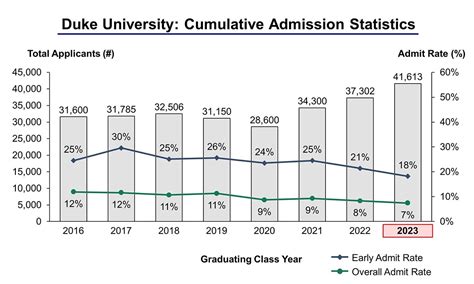Aspiring transfer students eager to join the prestigious Duke University often wonder about their chances of admission. This article provides an in-depth analysis of Duke’s transfer acceptance rate, shedding light on the highly competitive selection process.

Duke University Transfer Acceptance Rate
Duke University has a highly selective transfer admission process, with limited availability for transfer students. The overall transfer acceptance rate for the 2023-2024 application cycle was 6.7%, significantly lower than the freshman acceptance rate of 8.8%.
Factors Influencing Transfer Acceptance
The transfer admission committee at Duke University considers various factors in evaluating applications, including:
- Academic Performance: A strong academic record with a high GPA and challenging coursework is crucial.
- Standardized Test Scores: ACT or SAT scores are typically required, and competitive scores can enhance an application.
- Personal Statement: The personal statement is an opportunity for applicants to showcase their unique perspectives, experiences, and goals.
- Letter of Recommendation: Strong letters of recommendation from professors or other individuals who can attest to the applicant’s academic ability and character are valuable.
- Extracurricular Activities: Involvement in extracurricular activities that demonstrate leadership skills, community engagement, or personal growth can strengthen an application.
How to Improve Transfer Chances
To increase the likelihood of admission to Duke University as a transfer student, consider the following strategies:
- Maintain a High GPA: Focus on earning consistently high grades in your current institution.
- Excel in Challenging Coursework: Take on rigorous coursework that aligns with your intended major at Duke University.
- Prepare for Standardized Tests: Study diligently for the ACT or SAT to achieve competitive scores.
- Craft a Compelling Personal Statement: Write a thought-provoking and well-written personal statement that showcases your strengths, aspirations, and fit with Duke University.
- Secure Strong Letters of Recommendation: Request letters of recommendation from professors or individuals who know you well and can highlight your academic abilities and character.
- Participate in Extracurricular Activities: Engage in meaningful extracurricular activities that demonstrate your leadership, community involvement, and personal interests.
Transfer Deadlines and Application Process
Duke University has established specific deadlines for transfer applications:
- Fall Transfer: November 1 (Early Decision) / January 15 (Regular Decision)
- Spring Transfer: March 15 (Application Deadline)
The transfer application process involves submitting an online application, official transcripts, standardized test scores, personal statement, letters of recommendation, and other required materials.
Additional Tips for Success
- Research Duke University: Learn about Duke’s academic programs, campus culture, and student life to ensure it is a good fit for you.
- Attend Campus Events: Visit Duke University’s campus or participate in virtual events to connect with current students and faculty.
- Consider Early Decision: Applying Early Decision indicates your strong interest in Duke University and may improve your chances of admission.
- Be Persistent: If you are not admitted to Duke University as a transfer student, consider reapplying in future application cycles.
Frequently Asked Questions (FAQs)
- What is the average GPA of admitted transfer students? The average GPA of admitted transfer students at Duke University is typically above 3.7.
- What is the typical range of ACT/SAT scores for admitted transfer students? The middle 50% range of ACT scores for admitted transfer students is 32-35, and the middle 50% range of SAT scores is 1430-1550.
- Does Duke University offer transfer scholarships? Duke University offers merit-based scholarships and need-based financial aid to qualified transfer students.
- How large is the transfer class? The size of the transfer class at Duke University varies each year, but typically comprises around 300 students.
Conclusion
The Duke University transfer acceptance rate is highly competitive, requiring strong academic performance, involvement in extracurricular activities, and a compelling application. By following the strategies outlined in this article, prospective transfer students can enhance their chances of securing a place at this prestigious institution.
